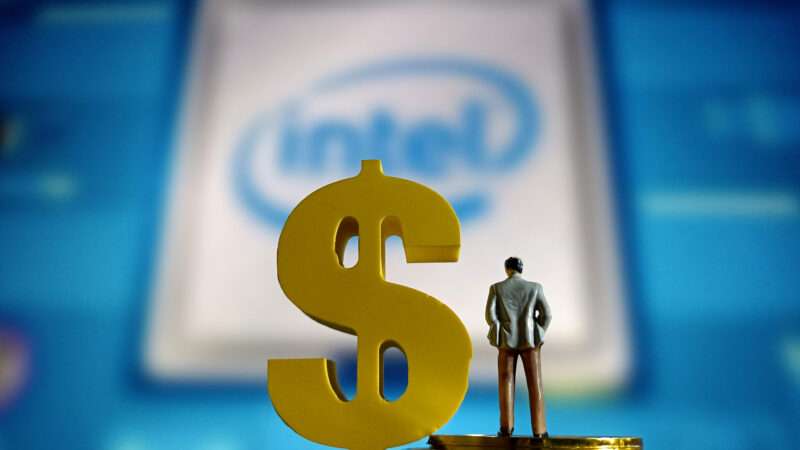
American chipmaker Intel will receive up to $19 billion in corporate welfare, the White House announced Wednesday, making it likely to be the largest recipient of taxpayer-funded aid intended to boost semiconductor manufacturing.
President Joe Biden is expected to make a formal announcement of the handout later today during a campaign stop at Intel's headquarters in Chandler, Arizona. In a statement, the White House said the subsidies would include $8.5 billion in direct grants to Intel, which will also have access to $11 billion in federal loans. For all that money, Intel is expected to create 30,000 jobs.
In other words, taxpayers will pony up over $283,000 per job created—and that's counting only the $8.5 billion in direct payments to the company.
The math gets even worse if you read Intel's press release, which clarifies that 20,000 of those 30,000 new jobs will be temporary construction jobs connected to building new facilities in four states.
But the real kicker is the fact that Intel was already planning to build those facilities—which makes sense, because there is huge demand for semiconductors and the market is growing increasingly concerned about the fact that so many of the world's high-end chips are made in Taiwan and are thus under constant threat from China. According to Intel, the federal government's handout "supports Intel's previously announced plans to invest more than $100 billion in the U.S. over five years to expand U.S. chipmaking capacity."
To sum up: The federal government is spending heavily to subsidize a successful, growing industry, is asking taxpayers to foot part of the bill for investments that the private sector was already funding, and is not spending the money in a particularly efficient way. Make it make sense!
Unfortunately, this is likely only the start. The Biden administration still has $39 billion in CHIPS Act subsidies to distribute in the coming months, according to The New York Times. Even before that money is out the door—and long before anyone has had a chance to measure how effective the spending was—administration officials and top executives at chip-making companies agree that Congress should pass another round of subsidies.
"I do think we'll need at least a CHIPS 2 to finish that job," Patrick Gelsinger, Intel's chief executive, told the Times this week, echoing comments made last month by Commerce Secretary Gina Raimondo, who is overseeing the distribution of this corporate welfare.
Even if the semiconductor industry needed government handouts—which, again, it clearly does not—directly subsidizing certain projects and companies would be a poor way to go about it.
For evidence, check out a new paper from Alex Muresianu, a senior policy analyst at the Tax Foundation (and former Reason intern), that contrasts the approaches taken by the CHIPs Act vs. the 2017 Tax Cuts and Jobs Act signed by then-President Donald Trump. By reducing corporate taxes and enacting a series of supply-side reforms, Muresianu concludes, the Trump tax cuts "caused a substantial increase in investment."
"In contrast," he writes, the targeted subsidies included in the CHIPs Act "have not led to a broad increase in private investment outside of subsidized sectors."
At National Review, Dominic Pino explains why this distinction matters. "Supply-side orthodoxy and industrial policy often have a similar goal: to increase capital investment. But they go about pursuing that goal in very different ways." Neutral reforms like tax cuts reduce the cost of capital investments and allow private markets to decide how best to allocate new investments.
On the other hand, industrial policies like the grants to Intel "requires a series of bank shots," Pino writes. The government has to pick which sector of the economy to subsidize and has to choose specific winners and losers within that sector, of course. Then, it also has to decide how much to invest in each company and make sure those subsidies aren't displacing private investments—and it has to do all of that "in the absence of reliable price signals and persist through relentless pressure from advocacy groups."
Of course, specific subsidies for certain companies create something that broader reforms for the economy do not: the chance for the president to stand in front of a construction site and take credit for the jobs being created there.
Even if they are tremendously costly to the taxpayers. And even if those jobs were going to be created anyway.
The post Federal Handout to Intel Will Cost $283,000 Per Job, and That's Being Generous appeared first on Reason.com.







